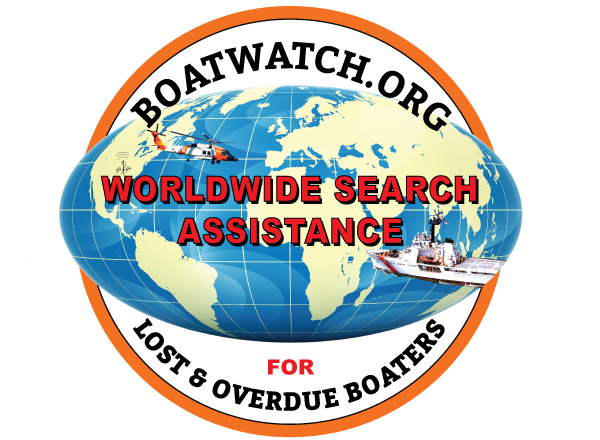By Steven Bowden, former owner of SeaTech Systems.
Every day in my former business I answered the same question: Do I really need a High Frequency (HF) Single Sideband (SSB) radio for long range cruising? Why not just use a satellite phone or satellite hotspot? Why do most long range cruisers use a 100 year old radio technology? Isn’t HF radio obsolete?
My answer was always yes, you do indeed need this cost effective, reliable, and amazingly versatile method of long range communication on your boat.
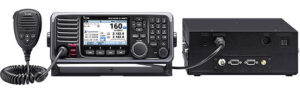
The new (2020) Icom M803 replaces the venerable M802 as the gold standard SSB radio for leisure boaters cruising the high seas
Unlike marine Very High Frequency (VHF) Frequency Modulation (FM) radio which uses a short range, line of sight signal, the reason HF radio works so well for long distance cruising is that it uses the phenomenon of skywave or ‘skip’ propagation. This refers to the characteristics of electromagnetic radiation we call radio waves when they are transmitted at an angle from one point to another. These waves then reflect or refract back to earth from layers of ionized atoms in the atmosphere. This skip effect allows long range transmission beyond the horizon and even globally. While propagation can be affected by various atmospheric conditions, HF radio remains a consistently reliable performer in a surprising variety of conditions.
Cruising is a community. HF radio connects you to this community in the form of cruising nets, huge wireless ‘party lines’ that allow you to share news and information. Many cruisers develop lifelong friendships based on ‘keeping in touch’ over HF radio. This ‘one to many’ communications method means that you can connect to the even larger worldwide amateur or ‘ham’ radio community in emergencies — a very important advantage in remote locations. HF radios can also be used to make calls to telephones anywhere in the world. This technique involves contacting a commercial shore service provider for a fee. Many ham operators provide this service for free to licensed hams.
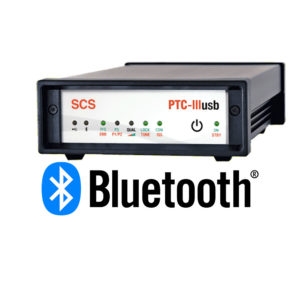
Adding a Pactor modem to your SSB opens up an entire world of long-range email, weather, and more.
The most popular reason for the proliferation of HF radio is digital communications. This refers to the ability to send and receive digital data through a wireless email service provider such as low cost SailMail or the free ham service Winlink. This capability is based on the SCS Pactor radio modem. A sender creates an email in a software program called AirMail. This digital data is converted to analog by the modem, then transmitted by the HF radio to a shore station. This station receives the analog data, a modem converts it to digital and sends it to the email address anywhere in the world. Thousands of cruisers, racers, commercial and military users have made HF radio email a reliable standard for over 14 years.
A great way to enhance your HF radio knowledge and access restricted frequencies in your HF radio is to obtain a ham license. This consists of studying a pool of questions on subjects such as propagation, antennas, radio frequency (RF) safety, and the radio regulations of the government granting the license. Licenses are recognized in most countries. In the US, a General Class license is required to access Winlink for worldwide free email service. No commercial messages are allowed on ham bands.
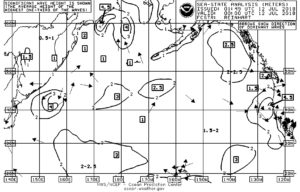
Here’s what a NOAA weatherfax looks like. There are many different forecasts you can choose to receive by weatherfax.
Weather knowledge is a religion for long range cruising. In order to be self reliant forecasters, cruisers must have access to weather data that is broadcast worldwide by various government weather services for free. These broadcasts include weather fax (wxfax), navigational text (navtex), text (telex) and GRIdded Binary files (GRIB) as well as voice broadcasts. Weather reports or products are broadcast at regular intervals as long range HF radio waves and can be easily converted to digital data by demodulators, computer sound cards or radio modems and displayed as graphics and text by computer software. GRIBs are sent as free emails and are based on computer models of current and future wind conditions. Weather routers can also be accessed by HF radio for those that wish to speak directly to a meteorologist.
Many cruisers enjoy listening to their favorite news, sports and entertainment broadcasts on the British Broadcasting Corporation (BBC) and Voice of America (VOA) worldwide services as well as a proliferation of shortwave programs across the radio spectrum.
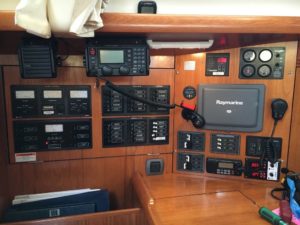
S/V Mobert’s SSB mounted at the nav station.
Safety is obviously the most important reason for having a HF radio on your boat. Long a standard for long range emergency communication, marine HF radio has a serious 150 watts of transmit power to get your message out and someone is always listening. Unlike the very important Emergency Position-Indicating Radio Beacons (EPIRBs), voice communications over HF radio can access emergency medical services or request medical assistance. Some emergencies aren’t life threatening and an HF radio can summon help from authorities or fellow cruisers that might save your boat.
The recent addition of the proven, worldwide Digital Selective Calling (DSC) to HF radio has gone a long way to enhance its safety. This system allows you to broadcast an emergency digital signal by pushing one button. This message contains information about you and your vessel, the nature of your emergency and your Global Positioning System (GPS) coordinates. In addition, an ‘individual calling’ feature of DSC allows you to signal other vessels if you have their Maritime Mobile Service Identity (MMSI) number. This number is broadcast on the global standard Automatic Information System (AIS) by all commercial vessels. Unlike the DSC system on marine VHF FM radios which have about a 20 nautical mile range, HF DSC is long range and therefore can reach a larger number of commercial or recreational vessels from remote locations.
DSC allows you participate in the worldwide search and rescue network called the Global Maritime Distress Safety System (GMDSS). All commercial vessels are part of a convention call the Safety of Life at Sea (SOLAS) which obligates them to render assistance to any vessel that contacts them. Help is given either directly or by relaying messages to authorities.
Despite the overwhelming evidence that that HF radio is a vital communications tool, some people think they are past their prime. I asked a variety of marine industry experts, cruising authors and instructors the question, “Is HF SSB Radio obsolete?” and here are some of their opinions:
Lee Chesneau, former Senior Meteorologist for the National Weather Service and USCG approved STCW Instructor “Not by a long shot. An essential method for gathering weather data worldwide. Don’t leave port without it!”
Gwen Hamlin, Women and Cruising Seminars and author of the Admiral’s Angle, “The Women and Cruising team all continue to promote SSB/ham radio based on our experiences. I still see no easy way to stay in touch with new friends as they change anchorages or as they share passages out of VHF range, and I have trouble imagining not having access to local area nets and weather, not to mention the comfort of the long distance passage nets like Seafarers or the fall-back dependability of the Maritime Mobile Net.”
Eric Steinberg, owner of Farallon Electronics, Pactor distributor, and supplier of electronics to the America’s Cup, “By all measures, the advantages of SSB are alive and well and not going away any time soon.”
Capt. Marti Brown, author of Marine SSB for Idi-Yachts and the ICOM M802 Manual for Idi-Yachts, “A radio is a networking tool that connects people. The rest of the expensive gadgetry is nice if you can afford it. My recommendation from my many years cruising is, ‘Don’t go offshore without a marine SSB radio. Stay safe and stay well!’”
Capts. Jeff & Jean Grossman, Two Can Sail Couples Seminars, ASA sailing instructors and SAMS surveyors, “We strongly feel that SSB is important for couples cruising long distance. It connects you to many stations at once and allows you to be part of the cruising net community, both powerful safety and security features.”
Pam Wall, Cruising and Sailing Consultant as well as a professional marine outfitter, “I would not go to sea, or suggest anyone go to sea, without a Single Side Band Radio!!! In the many miles of sailing I have done for over 50 years, the Single Side Band radio has been my link, to other yachtsmen at sea, home, weather information, contact with radio nets around the world, possible distress communication, and an invaluable instrument that I consider one of the most important on my boat. Someday I am going to write a book about all the times I have used, and needed to use, the SSB while circumnavigating, sailing offshore or inland, and just day sailing as well. It is always reliable and, for sure, my communication link that I could not do without.”
Chris Parker, If you are planning a long-term cruise, there is still no better way than SSB radio to participate in real time discussions with your cruising friends and community, request assistance, and talk with a professional weather router on my team at Marine Weather Center. I would not put to sea without a reliable, well installed marine SSB radio.
Recommended Reading
Check out our great selection of SSB books.
More SSB Resources
- Federal Communications Commission (FCC)
- Winlink
- Terry Sparks’ “Made Simple for Cruisers” books
- Global Maritime Distress and Safety System (GMDSS)
- Gordon West Radio School
- About DSC
- Chris Parker’s Marine Weather Center
- Seven Seas Cruising Association
- Noonsite
- Saildocs
- Sailmail Association
- SSB Radio Nets
- Lee Chesneau’s Marine Weather
- Capt. Marti’s Idi-Yacht Books
- Maritime Mobile Service Network
- World Cruising Club
- Waterway Radio
- NOAA Marine Radiofax Charts
- National Association for Amateur Radio
Steven Bowden (aka cap’n greybeard) and his smarter partner Pamela House formerly owned SeaTech Systems. They now devote their time to teaching and traveling.
